Accounting Standards and Regulation: Myer Holdings Impairment Report
VerifiedAdded on 2020/03/02
|9
|1804
|50
Report
AI Summary
This report provides an in-depth analysis of the impairment of assets for Myer Holdings Ltd., an Australian Stock Exchange (ASX) listed company. It focuses on the application of AASB 136, detailing the evidence of impairment, the process for determining impairment, the information required for impairment calculations, and the flexibility afforded to management in making these determinations. The report references ASIC media releases and financial data to assess whether Myer Holdings Ltd. exhibits signs of impairment based on asset base, turnover, and flow. It also examines specific actions taken by the company, such as store modifications, that could indicate potential impairment triggers. The report covers the process of calculating impairment using value-in-use and recoverable value, including assumptions like terminal growth rates and discount rates. It also outlines the necessary disclosures and the ability of management to seek expert advice. The report provides a comprehensive overview of impairment accounting in the context of a real-world case study.
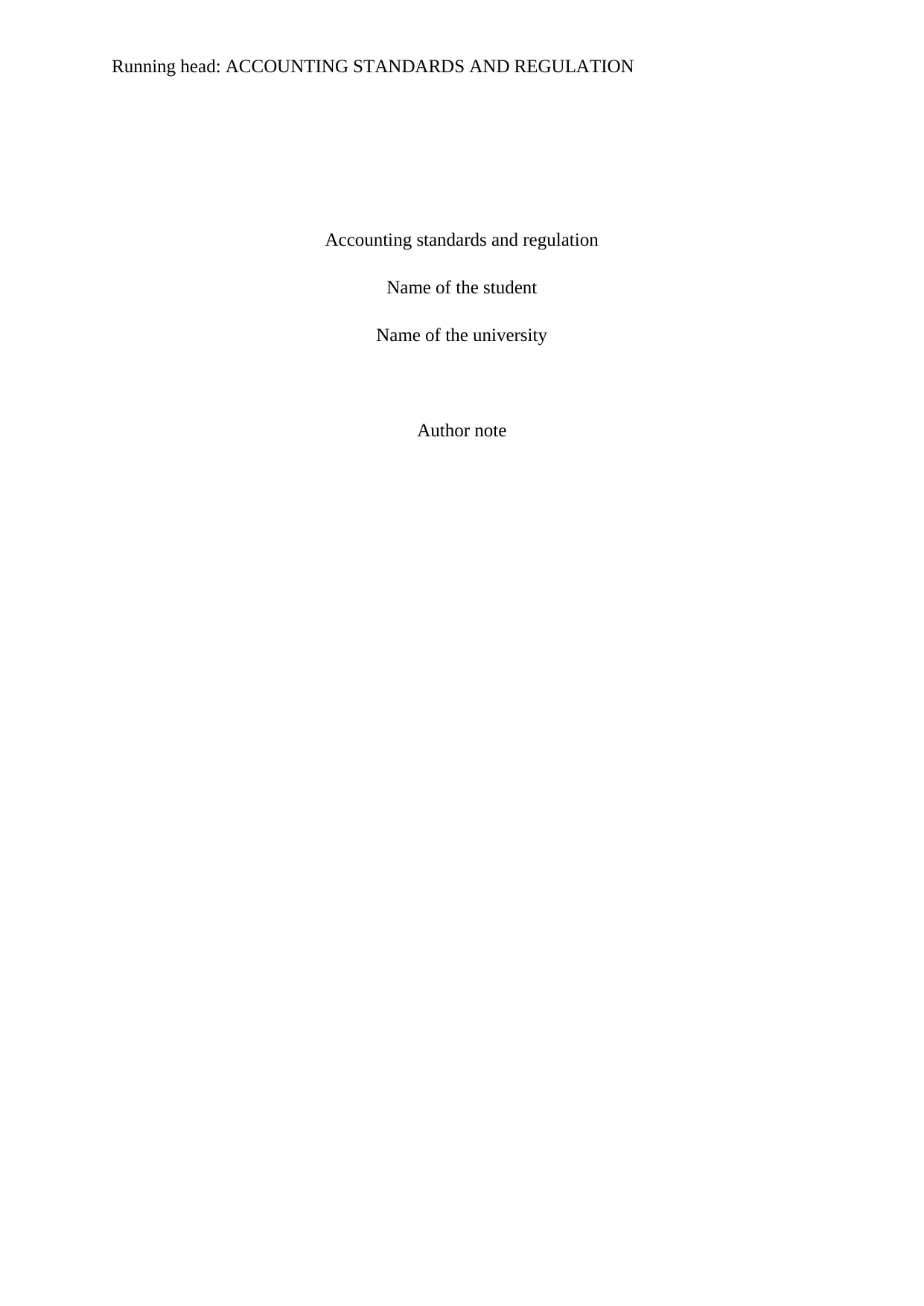
Running head: ACCOUNTING STANDARDS AND REGULATION
Accounting standards and regulation
Name of the student
Name of the university
Author note
Accounting standards and regulation
Name of the student
Name of the university
Author note
Paraphrase This Document
Need a fresh take? Get an instant paraphrase of this document with our AI Paraphraser
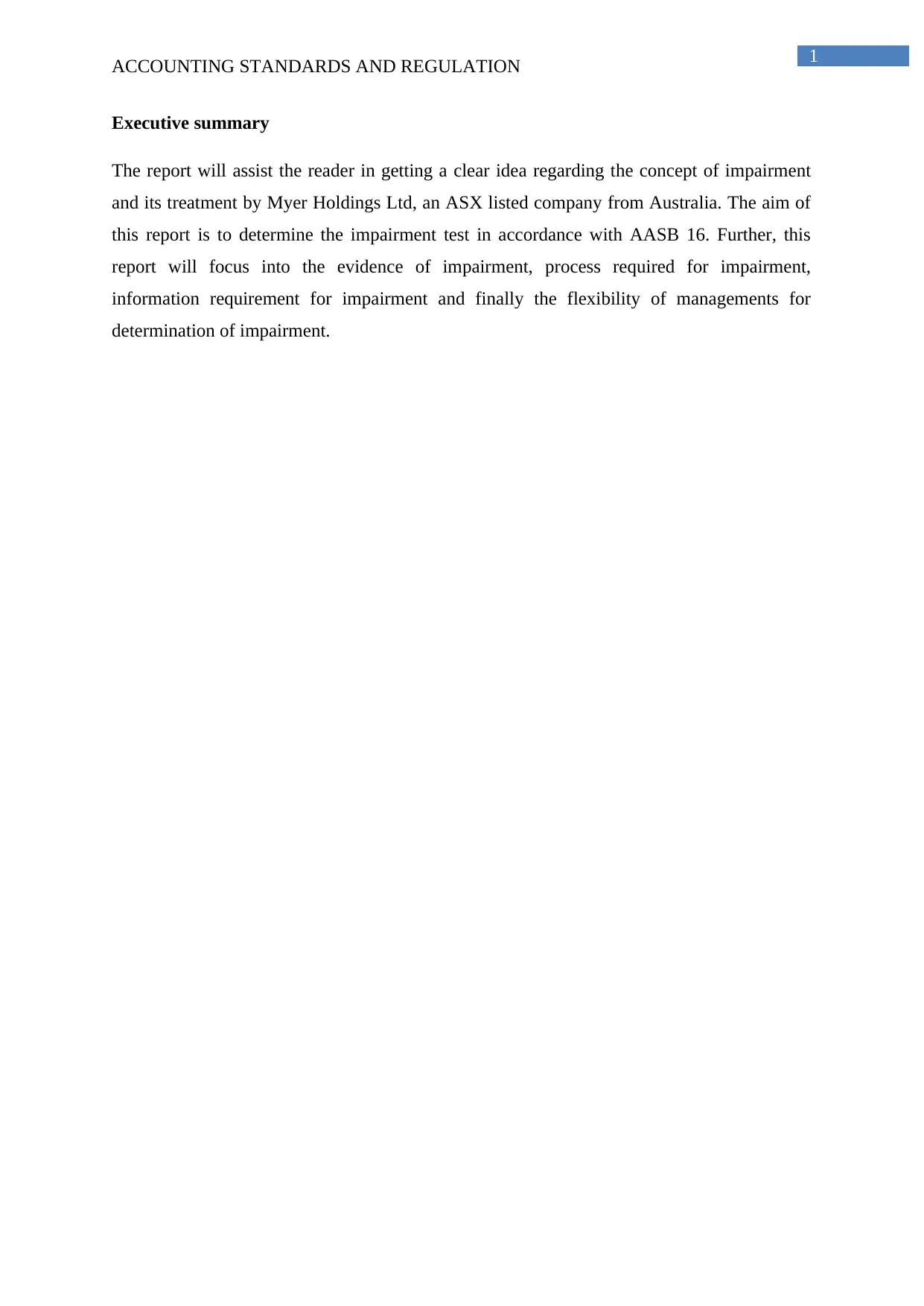
1
ACCOUNTING STANDARDS AND REGULATION
Executive summary
The report will assist the reader in getting a clear idea regarding the concept of impairment
and its treatment by Myer Holdings Ltd, an ASX listed company from Australia. The aim of
this report is to determine the impairment test in accordance with AASB 16. Further, this
report will focus into the evidence of impairment, process required for impairment,
information requirement for impairment and finally the flexibility of managements for
determination of impairment.
ACCOUNTING STANDARDS AND REGULATION
Executive summary
The report will assist the reader in getting a clear idea regarding the concept of impairment
and its treatment by Myer Holdings Ltd, an ASX listed company from Australia. The aim of
this report is to determine the impairment test in accordance with AASB 16. Further, this
report will focus into the evidence of impairment, process required for impairment,
information requirement for impairment and finally the flexibility of managements for
determination of impairment.
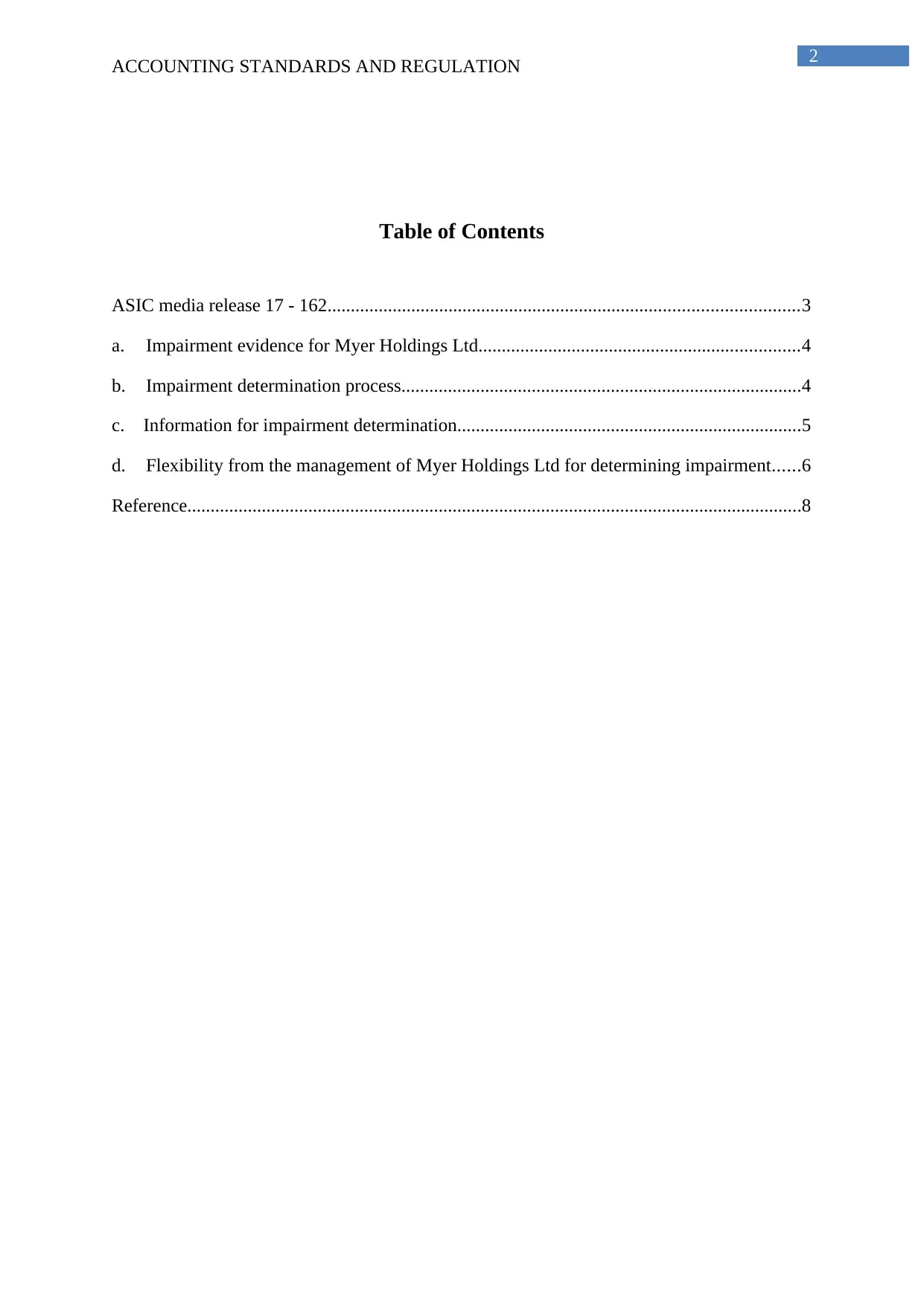
2
ACCOUNTING STANDARDS AND REGULATION
Table of Contents
ASIC media release 17 - 162.....................................................................................................3
a. Impairment evidence for Myer Holdings Ltd.....................................................................4
b. Impairment determination process......................................................................................4
c. Information for impairment determination..........................................................................5
d. Flexibility from the management of Myer Holdings Ltd for determining impairment......6
Reference....................................................................................................................................8
ACCOUNTING STANDARDS AND REGULATION
Table of Contents
ASIC media release 17 - 162.....................................................................................................3
a. Impairment evidence for Myer Holdings Ltd.....................................................................4
b. Impairment determination process......................................................................................4
c. Information for impairment determination..........................................................................5
d. Flexibility from the management of Myer Holdings Ltd for determining impairment......6
Reference....................................................................................................................................8
⊘ This is a preview!⊘
Do you want full access?
Subscribe today to unlock all pages.

Trusted by 1+ million students worldwide
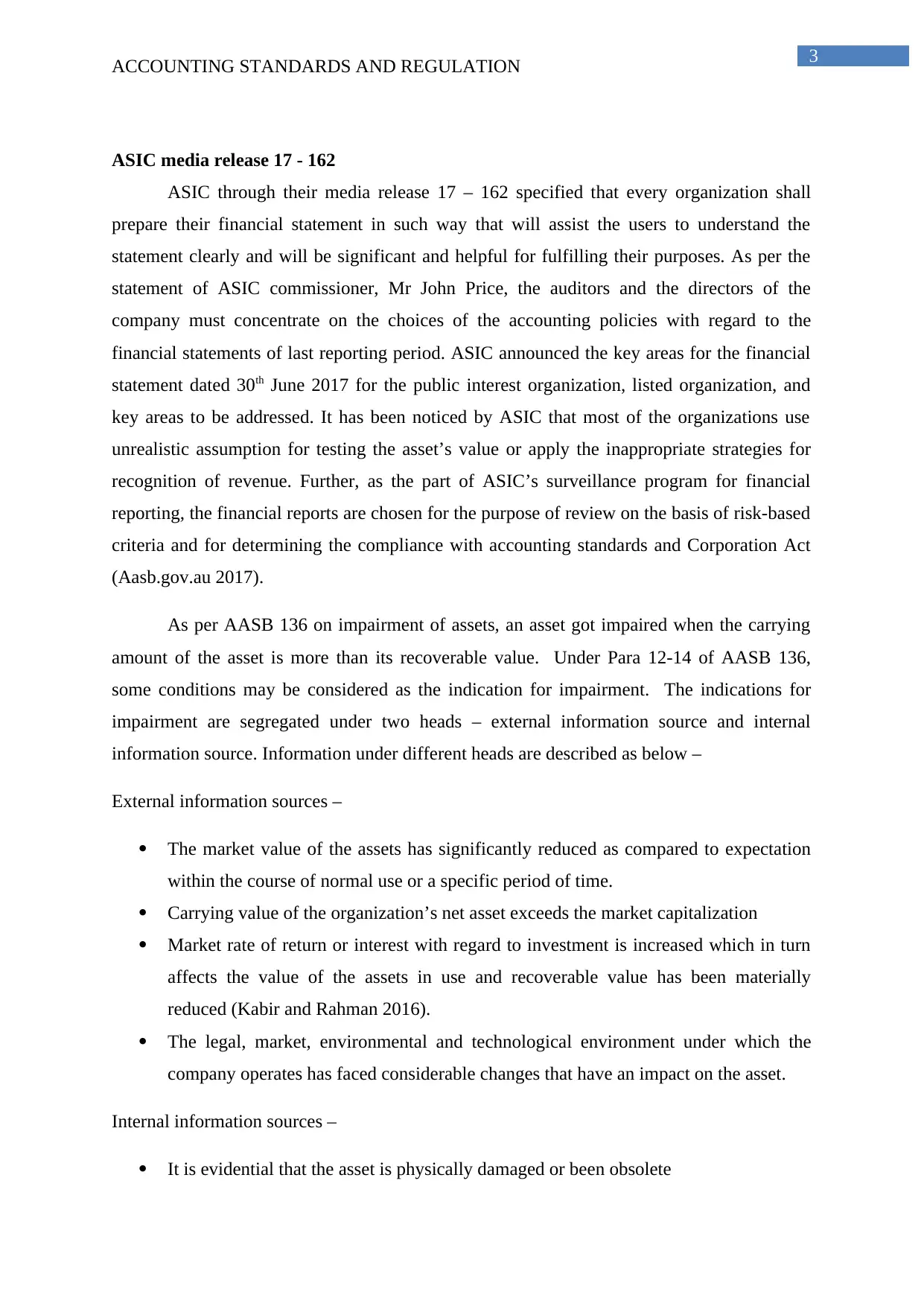
3
ACCOUNTING STANDARDS AND REGULATION
ASIC media release 17 - 162
ASIC through their media release 17 – 162 specified that every organization shall
prepare their financial statement in such way that will assist the users to understand the
statement clearly and will be significant and helpful for fulfilling their purposes. As per the
statement of ASIC commissioner, Mr John Price, the auditors and the directors of the
company must concentrate on the choices of the accounting policies with regard to the
financial statements of last reporting period. ASIC announced the key areas for the financial
statement dated 30th June 2017 for the public interest organization, listed organization, and
key areas to be addressed. It has been noticed by ASIC that most of the organizations use
unrealistic assumption for testing the asset’s value or apply the inappropriate strategies for
recognition of revenue. Further, as the part of ASIC’s surveillance program for financial
reporting, the financial reports are chosen for the purpose of review on the basis of risk-based
criteria and for determining the compliance with accounting standards and Corporation Act
(Aasb.gov.au 2017).
As per AASB 136 on impairment of assets, an asset got impaired when the carrying
amount of the asset is more than its recoverable value. Under Para 12-14 of AASB 136,
some conditions may be considered as the indication for impairment. The indications for
impairment are segregated under two heads – external information source and internal
information source. Information under different heads are described as below –
External information sources –
The market value of the assets has significantly reduced as compared to expectation
within the course of normal use or a specific period of time.
Carrying value of the organization’s net asset exceeds the market capitalization
Market rate of return or interest with regard to investment is increased which in turn
affects the value of the assets in use and recoverable value has been materially
reduced (Kabir and Rahman 2016).
The legal, market, environmental and technological environment under which the
company operates has faced considerable changes that have an impact on the asset.
Internal information sources –
It is evidential that the asset is physically damaged or been obsolete
ACCOUNTING STANDARDS AND REGULATION
ASIC media release 17 - 162
ASIC through their media release 17 – 162 specified that every organization shall
prepare their financial statement in such way that will assist the users to understand the
statement clearly and will be significant and helpful for fulfilling their purposes. As per the
statement of ASIC commissioner, Mr John Price, the auditors and the directors of the
company must concentrate on the choices of the accounting policies with regard to the
financial statements of last reporting period. ASIC announced the key areas for the financial
statement dated 30th June 2017 for the public interest organization, listed organization, and
key areas to be addressed. It has been noticed by ASIC that most of the organizations use
unrealistic assumption for testing the asset’s value or apply the inappropriate strategies for
recognition of revenue. Further, as the part of ASIC’s surveillance program for financial
reporting, the financial reports are chosen for the purpose of review on the basis of risk-based
criteria and for determining the compliance with accounting standards and Corporation Act
(Aasb.gov.au 2017).
As per AASB 136 on impairment of assets, an asset got impaired when the carrying
amount of the asset is more than its recoverable value. Under Para 12-14 of AASB 136,
some conditions may be considered as the indication for impairment. The indications for
impairment are segregated under two heads – external information source and internal
information source. Information under different heads are described as below –
External information sources –
The market value of the assets has significantly reduced as compared to expectation
within the course of normal use or a specific period of time.
Carrying value of the organization’s net asset exceeds the market capitalization
Market rate of return or interest with regard to investment is increased which in turn
affects the value of the assets in use and recoverable value has been materially
reduced (Kabir and Rahman 2016).
The legal, market, environmental and technological environment under which the
company operates has faced considerable changes that have an impact on the asset.
Internal information sources –
It is evidential that the asset is physically damaged or been obsolete
Paraphrase This Document
Need a fresh take? Get an instant paraphrase of this document with our AI Paraphraser
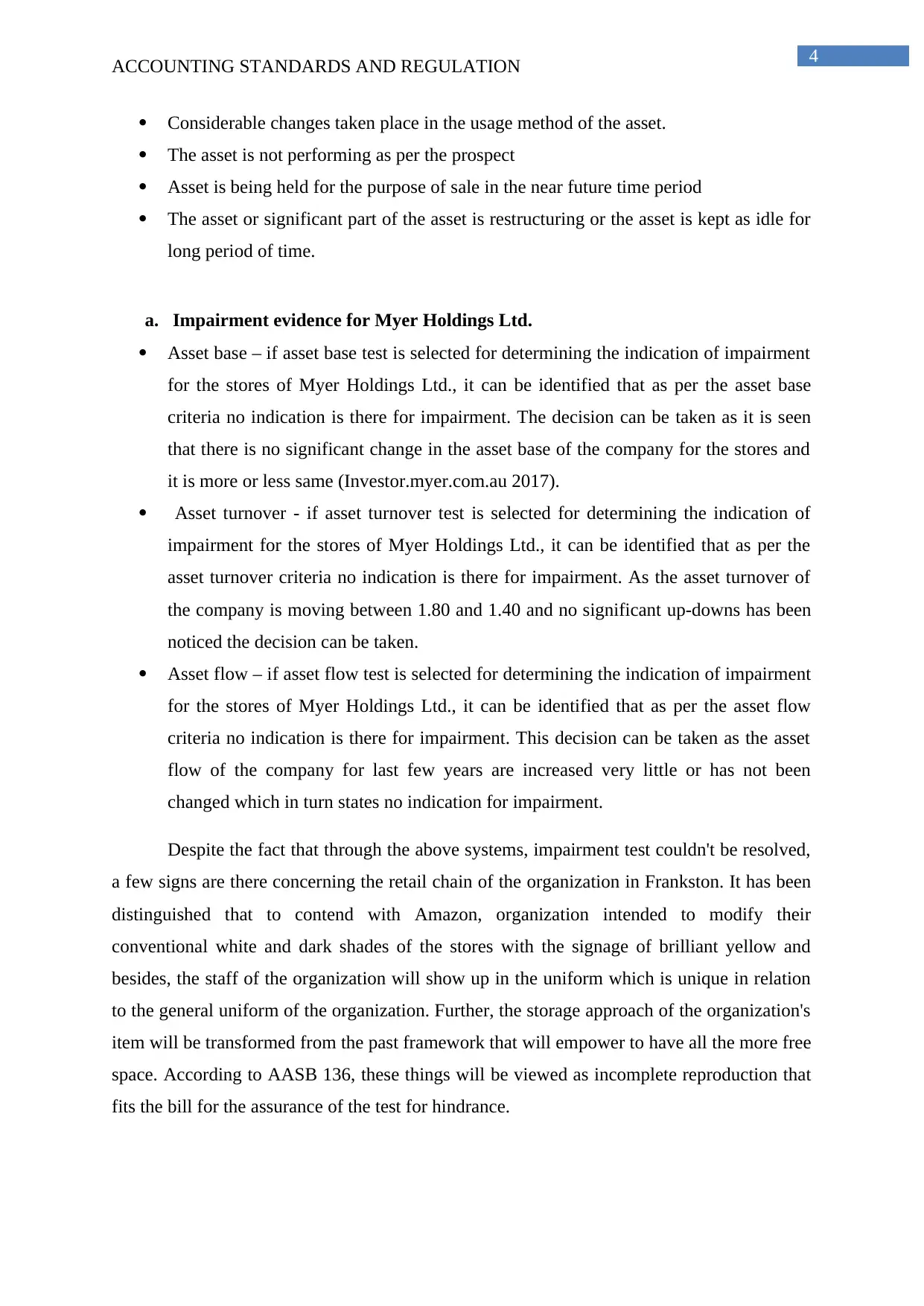
4
ACCOUNTING STANDARDS AND REGULATION
Considerable changes taken place in the usage method of the asset.
The asset is not performing as per the prospect
Asset is being held for the purpose of sale in the near future time period
The asset or significant part of the asset is restructuring or the asset is kept as idle for
long period of time.
a. Impairment evidence for Myer Holdings Ltd.
Asset base – if asset base test is selected for determining the indication of impairment
for the stores of Myer Holdings Ltd., it can be identified that as per the asset base
criteria no indication is there for impairment. The decision can be taken as it is seen
that there is no significant change in the asset base of the company for the stores and
it is more or less same (Investor.myer.com.au 2017).
Asset turnover - if asset turnover test is selected for determining the indication of
impairment for the stores of Myer Holdings Ltd., it can be identified that as per the
asset turnover criteria no indication is there for impairment. As the asset turnover of
the company is moving between 1.80 and 1.40 and no significant up-downs has been
noticed the decision can be taken.
Asset flow – if asset flow test is selected for determining the indication of impairment
for the stores of Myer Holdings Ltd., it can be identified that as per the asset flow
criteria no indication is there for impairment. This decision can be taken as the asset
flow of the company for last few years are increased very little or has not been
changed which in turn states no indication for impairment.
Despite the fact that through the above systems, impairment test couldn't be resolved,
a few signs are there concerning the retail chain of the organization in Frankston. It has been
distinguished that to contend with Amazon, organization intended to modify their
conventional white and dark shades of the stores with the signage of brilliant yellow and
besides, the staff of the organization will show up in the uniform which is unique in relation
to the general uniform of the organization. Further, the storage approach of the organization's
item will be transformed from the past framework that will empower to have all the more free
space. According to AASB 136, these things will be viewed as incomplete reproduction that
fits the bill for the assurance of the test for hindrance.
ACCOUNTING STANDARDS AND REGULATION
Considerable changes taken place in the usage method of the asset.
The asset is not performing as per the prospect
Asset is being held for the purpose of sale in the near future time period
The asset or significant part of the asset is restructuring or the asset is kept as idle for
long period of time.
a. Impairment evidence for Myer Holdings Ltd.
Asset base – if asset base test is selected for determining the indication of impairment
for the stores of Myer Holdings Ltd., it can be identified that as per the asset base
criteria no indication is there for impairment. The decision can be taken as it is seen
that there is no significant change in the asset base of the company for the stores and
it is more or less same (Investor.myer.com.au 2017).
Asset turnover - if asset turnover test is selected for determining the indication of
impairment for the stores of Myer Holdings Ltd., it can be identified that as per the
asset turnover criteria no indication is there for impairment. As the asset turnover of
the company is moving between 1.80 and 1.40 and no significant up-downs has been
noticed the decision can be taken.
Asset flow – if asset flow test is selected for determining the indication of impairment
for the stores of Myer Holdings Ltd., it can be identified that as per the asset flow
criteria no indication is there for impairment. This decision can be taken as the asset
flow of the company for last few years are increased very little or has not been
changed which in turn states no indication for impairment.
Despite the fact that through the above systems, impairment test couldn't be resolved,
a few signs are there concerning the retail chain of the organization in Frankston. It has been
distinguished that to contend with Amazon, organization intended to modify their
conventional white and dark shades of the stores with the signage of brilliant yellow and
besides, the staff of the organization will show up in the uniform which is unique in relation
to the general uniform of the organization. Further, the storage approach of the organization's
item will be transformed from the past framework that will empower to have all the more free
space. According to AASB 136, these things will be viewed as incomplete reproduction that
fits the bill for the assurance of the test for hindrance.
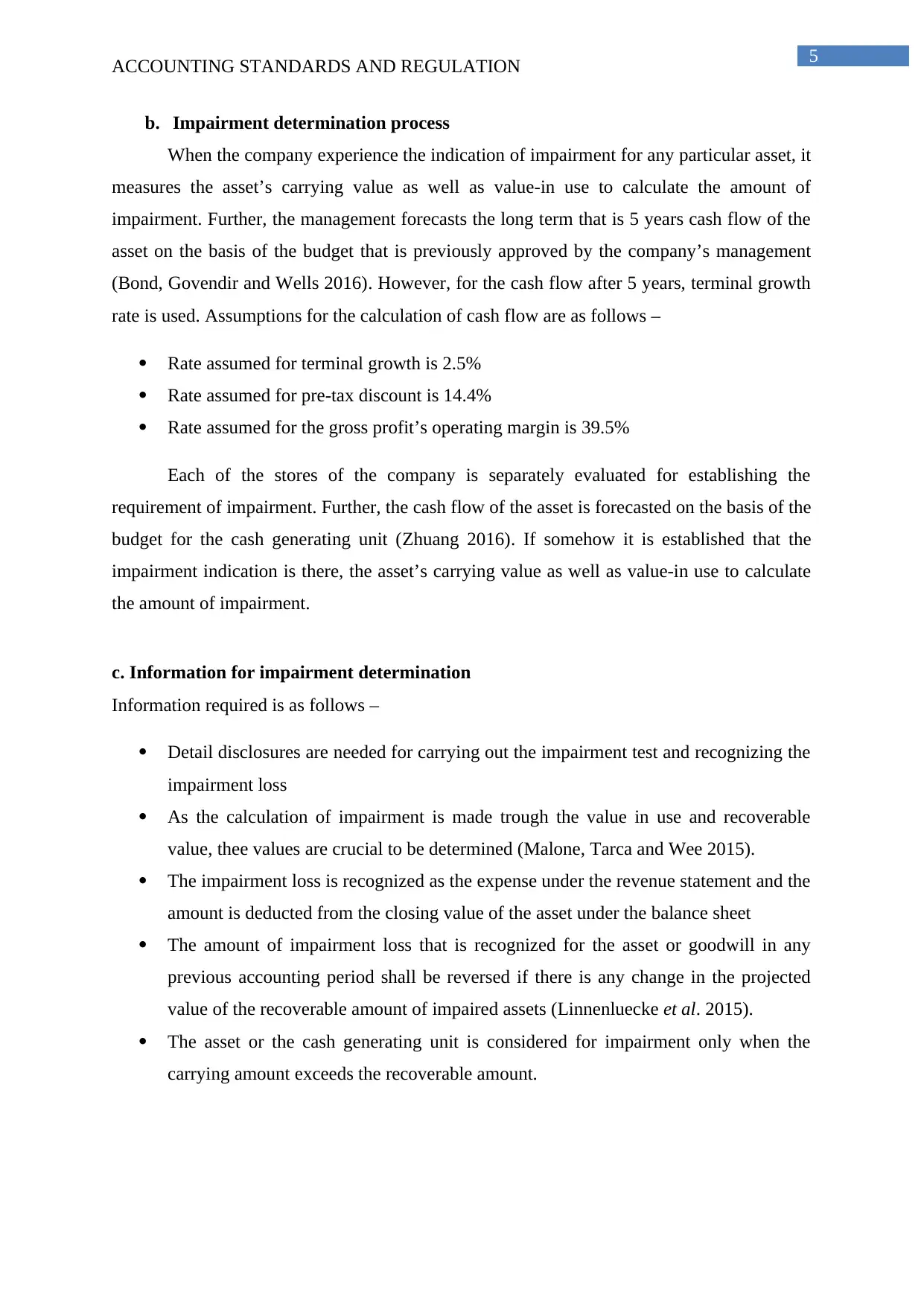
5
ACCOUNTING STANDARDS AND REGULATION
b. Impairment determination process
When the company experience the indication of impairment for any particular asset, it
measures the asset’s carrying value as well as value-in use to calculate the amount of
impairment. Further, the management forecasts the long term that is 5 years cash flow of the
asset on the basis of the budget that is previously approved by the company’s management
(Bond, Govendir and Wells 2016). However, for the cash flow after 5 years, terminal growth
rate is used. Assumptions for the calculation of cash flow are as follows –
Rate assumed for terminal growth is 2.5%
Rate assumed for pre-tax discount is 14.4%
Rate assumed for the gross profit’s operating margin is 39.5%
Each of the stores of the company is separately evaluated for establishing the
requirement of impairment. Further, the cash flow of the asset is forecasted on the basis of the
budget for the cash generating unit (Zhuang 2016). If somehow it is established that the
impairment indication is there, the asset’s carrying value as well as value-in use to calculate
the amount of impairment.
c. Information for impairment determination
Information required is as follows –
Detail disclosures are needed for carrying out the impairment test and recognizing the
impairment loss
As the calculation of impairment is made trough the value in use and recoverable
value, thee values are crucial to be determined (Malone, Tarca and Wee 2015).
The impairment loss is recognized as the expense under the revenue statement and the
amount is deducted from the closing value of the asset under the balance sheet
The amount of impairment loss that is recognized for the asset or goodwill in any
previous accounting period shall be reversed if there is any change in the projected
value of the recoverable amount of impaired assets (Linnenluecke et al. 2015).
The asset or the cash generating unit is considered for impairment only when the
carrying amount exceeds the recoverable amount.
ACCOUNTING STANDARDS AND REGULATION
b. Impairment determination process
When the company experience the indication of impairment for any particular asset, it
measures the asset’s carrying value as well as value-in use to calculate the amount of
impairment. Further, the management forecasts the long term that is 5 years cash flow of the
asset on the basis of the budget that is previously approved by the company’s management
(Bond, Govendir and Wells 2016). However, for the cash flow after 5 years, terminal growth
rate is used. Assumptions for the calculation of cash flow are as follows –
Rate assumed for terminal growth is 2.5%
Rate assumed for pre-tax discount is 14.4%
Rate assumed for the gross profit’s operating margin is 39.5%
Each of the stores of the company is separately evaluated for establishing the
requirement of impairment. Further, the cash flow of the asset is forecasted on the basis of the
budget for the cash generating unit (Zhuang 2016). If somehow it is established that the
impairment indication is there, the asset’s carrying value as well as value-in use to calculate
the amount of impairment.
c. Information for impairment determination
Information required is as follows –
Detail disclosures are needed for carrying out the impairment test and recognizing the
impairment loss
As the calculation of impairment is made trough the value in use and recoverable
value, thee values are crucial to be determined (Malone, Tarca and Wee 2015).
The impairment loss is recognized as the expense under the revenue statement and the
amount is deducted from the closing value of the asset under the balance sheet
The amount of impairment loss that is recognized for the asset or goodwill in any
previous accounting period shall be reversed if there is any change in the projected
value of the recoverable amount of impaired assets (Linnenluecke et al. 2015).
The asset or the cash generating unit is considered for impairment only when the
carrying amount exceeds the recoverable amount.
⊘ This is a preview!⊘
Do you want full access?
Subscribe today to unlock all pages.

Trusted by 1+ million students worldwide
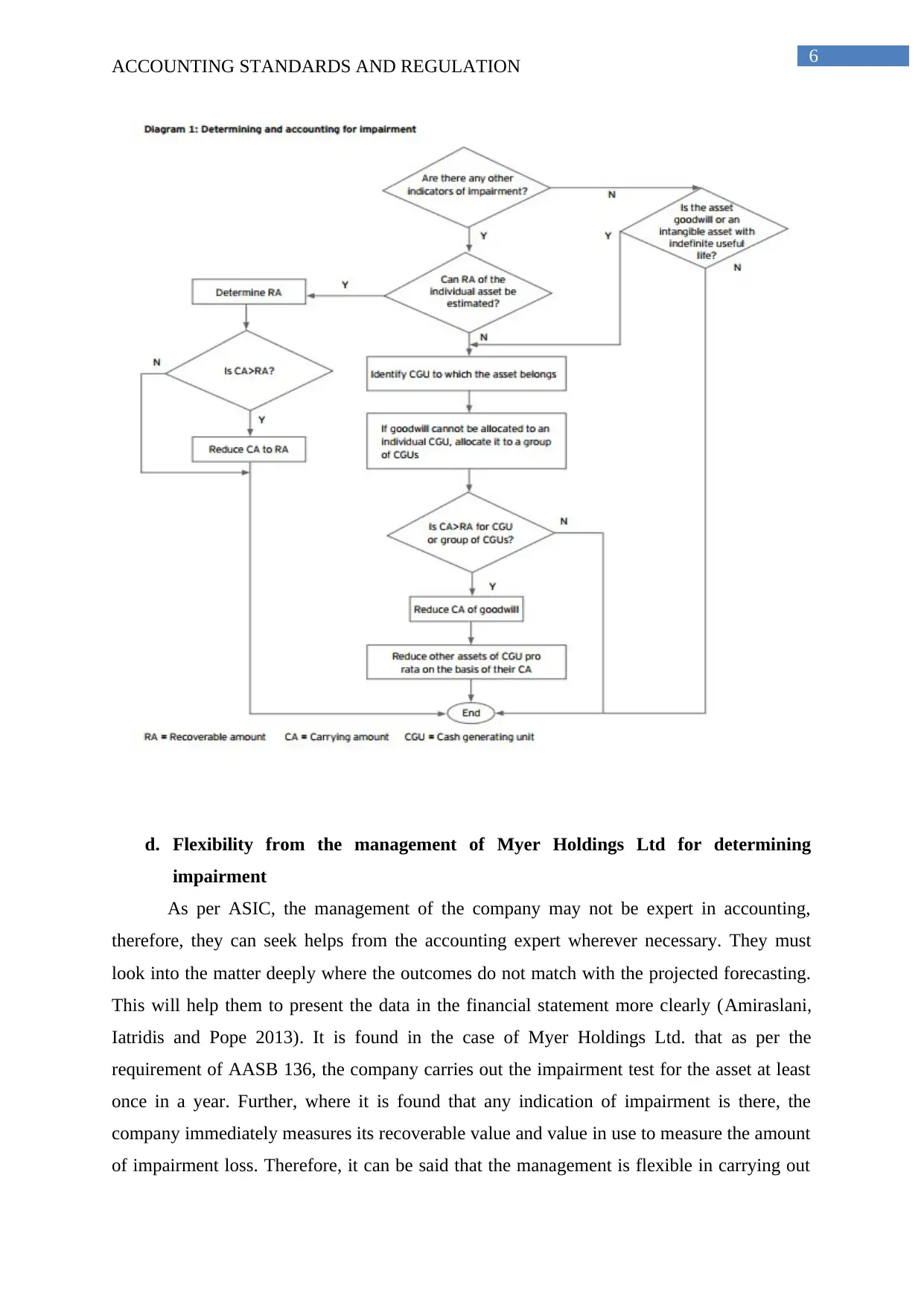
6
ACCOUNTING STANDARDS AND REGULATION
d. Flexibility from the management of Myer Holdings Ltd for determining
impairment
As per ASIC, the management of the company may not be expert in accounting,
therefore, they can seek helps from the accounting expert wherever necessary. They must
look into the matter deeply where the outcomes do not match with the projected forecasting.
This will help them to present the data in the financial statement more clearly (Amiraslani,
Iatridis and Pope 2013). It is found in the case of Myer Holdings Ltd. that as per the
requirement of AASB 136, the company carries out the impairment test for the asset at least
once in a year. Further, where it is found that any indication of impairment is there, the
company immediately measures its recoverable value and value in use to measure the amount
of impairment loss. Therefore, it can be said that the management is flexible in carrying out
ACCOUNTING STANDARDS AND REGULATION
d. Flexibility from the management of Myer Holdings Ltd for determining
impairment
As per ASIC, the management of the company may not be expert in accounting,
therefore, they can seek helps from the accounting expert wherever necessary. They must
look into the matter deeply where the outcomes do not match with the projected forecasting.
This will help them to present the data in the financial statement more clearly (Amiraslani,
Iatridis and Pope 2013). It is found in the case of Myer Holdings Ltd. that as per the
requirement of AASB 136, the company carries out the impairment test for the asset at least
once in a year. Further, where it is found that any indication of impairment is there, the
company immediately measures its recoverable value and value in use to measure the amount
of impairment loss. Therefore, it can be said that the management is flexible in carrying out
Paraphrase This Document
Need a fresh take? Get an instant paraphrase of this document with our AI Paraphraser
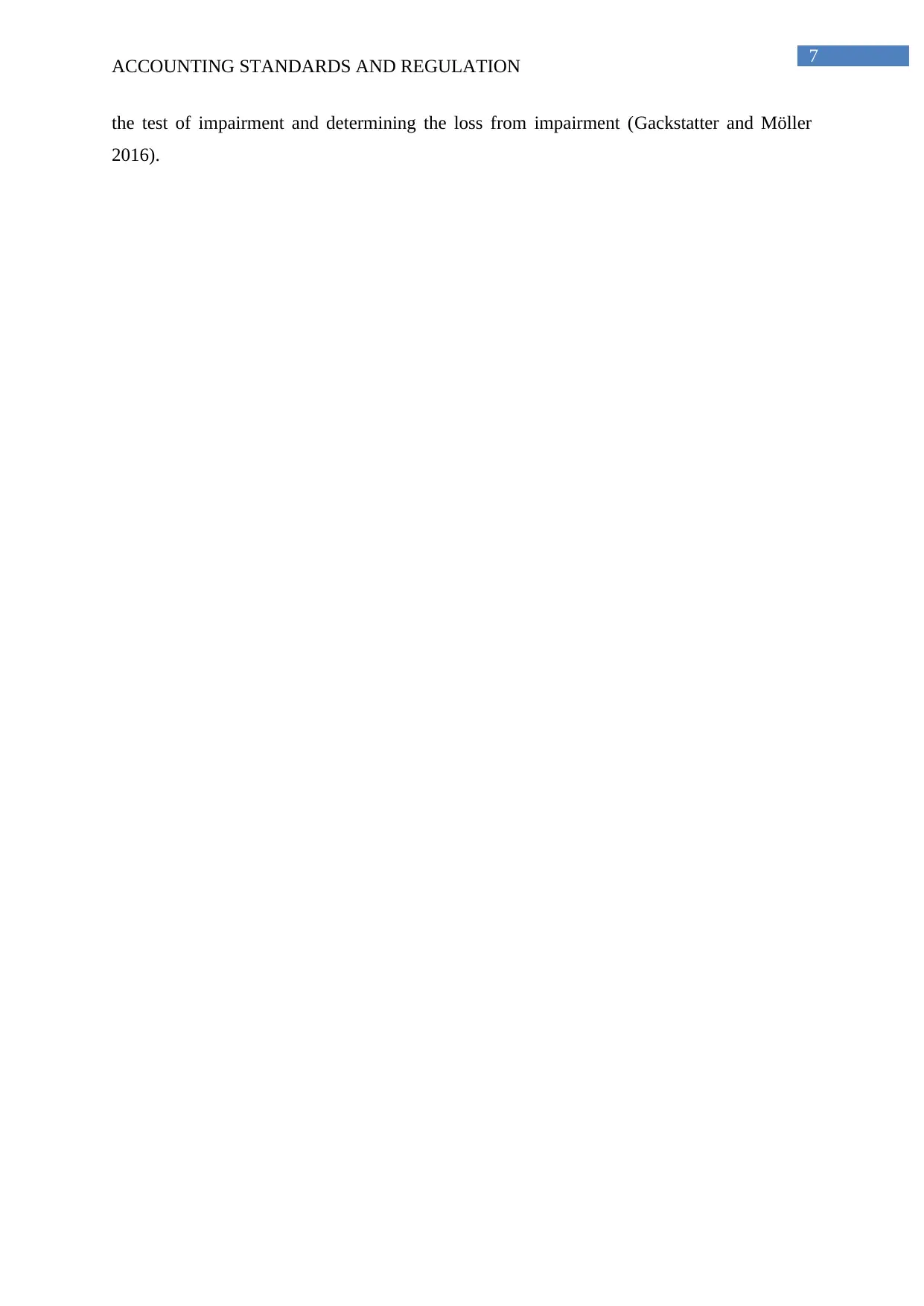
7
ACCOUNTING STANDARDS AND REGULATION
the test of impairment and determining the loss from impairment (Gackstatter and Möller
2016).
ACCOUNTING STANDARDS AND REGULATION
the test of impairment and determining the loss from impairment (Gackstatter and Möller
2016).
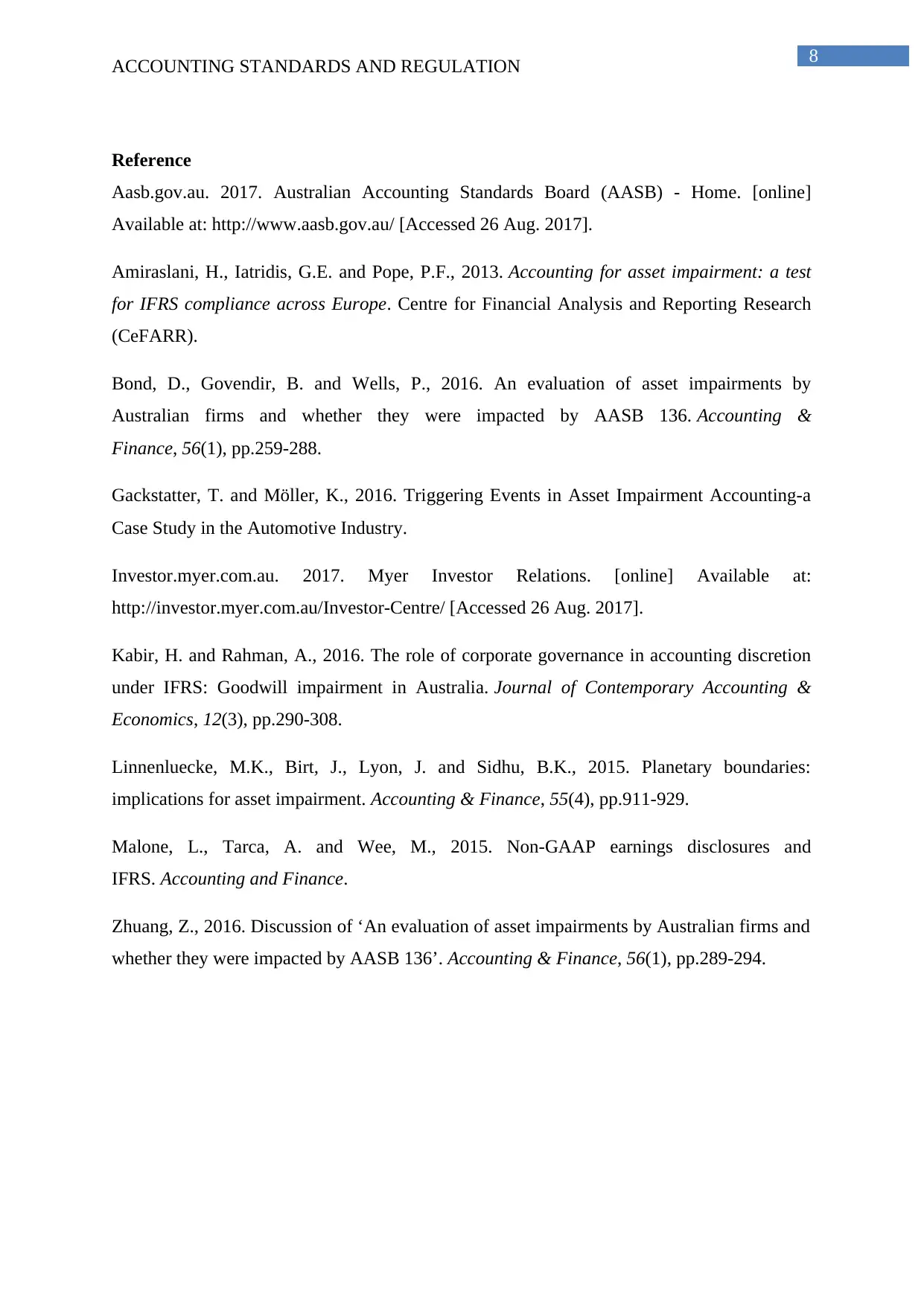
8
ACCOUNTING STANDARDS AND REGULATION
Reference
Aasb.gov.au. 2017. Australian Accounting Standards Board (AASB) - Home. [online]
Available at: http://www.aasb.gov.au/ [Accessed 26 Aug. 2017].
Amiraslani, H., Iatridis, G.E. and Pope, P.F., 2013. Accounting for asset impairment: a test
for IFRS compliance across Europe. Centre for Financial Analysis and Reporting Research
(CeFARR).
Bond, D., Govendir, B. and Wells, P., 2016. An evaluation of asset impairments by
Australian firms and whether they were impacted by AASB 136. Accounting &
Finance, 56(1), pp.259-288.
Gackstatter, T. and Möller, K., 2016. Triggering Events in Asset Impairment Accounting-a
Case Study in the Automotive Industry.
Investor.myer.com.au. 2017. Myer Investor Relations. [online] Available at:
http://investor.myer.com.au/Investor-Centre/ [Accessed 26 Aug. 2017].
Kabir, H. and Rahman, A., 2016. The role of corporate governance in accounting discretion
under IFRS: Goodwill impairment in Australia. Journal of Contemporary Accounting &
Economics, 12(3), pp.290-308.
Linnenluecke, M.K., Birt, J., Lyon, J. and Sidhu, B.K., 2015. Planetary boundaries:
implications for asset impairment. Accounting & Finance, 55(4), pp.911-929.
Malone, L., Tarca, A. and Wee, M., 2015. Non-GAAP earnings disclosures and
IFRS. Accounting and Finance.
Zhuang, Z., 2016. Discussion of ‘An evaluation of asset impairments by Australian firms and
whether they were impacted by AASB 136’. Accounting & Finance, 56(1), pp.289-294.
ACCOUNTING STANDARDS AND REGULATION
Reference
Aasb.gov.au. 2017. Australian Accounting Standards Board (AASB) - Home. [online]
Available at: http://www.aasb.gov.au/ [Accessed 26 Aug. 2017].
Amiraslani, H., Iatridis, G.E. and Pope, P.F., 2013. Accounting for asset impairment: a test
for IFRS compliance across Europe. Centre for Financial Analysis and Reporting Research
(CeFARR).
Bond, D., Govendir, B. and Wells, P., 2016. An evaluation of asset impairments by
Australian firms and whether they were impacted by AASB 136. Accounting &
Finance, 56(1), pp.259-288.
Gackstatter, T. and Möller, K., 2016. Triggering Events in Asset Impairment Accounting-a
Case Study in the Automotive Industry.
Investor.myer.com.au. 2017. Myer Investor Relations. [online] Available at:
http://investor.myer.com.au/Investor-Centre/ [Accessed 26 Aug. 2017].
Kabir, H. and Rahman, A., 2016. The role of corporate governance in accounting discretion
under IFRS: Goodwill impairment in Australia. Journal of Contemporary Accounting &
Economics, 12(3), pp.290-308.
Linnenluecke, M.K., Birt, J., Lyon, J. and Sidhu, B.K., 2015. Planetary boundaries:
implications for asset impairment. Accounting & Finance, 55(4), pp.911-929.
Malone, L., Tarca, A. and Wee, M., 2015. Non-GAAP earnings disclosures and
IFRS. Accounting and Finance.
Zhuang, Z., 2016. Discussion of ‘An evaluation of asset impairments by Australian firms and
whether they were impacted by AASB 136’. Accounting & Finance, 56(1), pp.289-294.
⊘ This is a preview!⊘
Do you want full access?
Subscribe today to unlock all pages.

Trusted by 1+ million students worldwide
1 out of 9
Related Documents
Your All-in-One AI-Powered Toolkit for Academic Success.
+13062052269
info@desklib.com
Available 24*7 on WhatsApp / Email
![[object Object]](/_next/static/media/star-bottom.7253800d.svg)
Unlock your academic potential
Copyright © 2020–2025 A2Z Services. All Rights Reserved. Developed and managed by ZUCOL.





